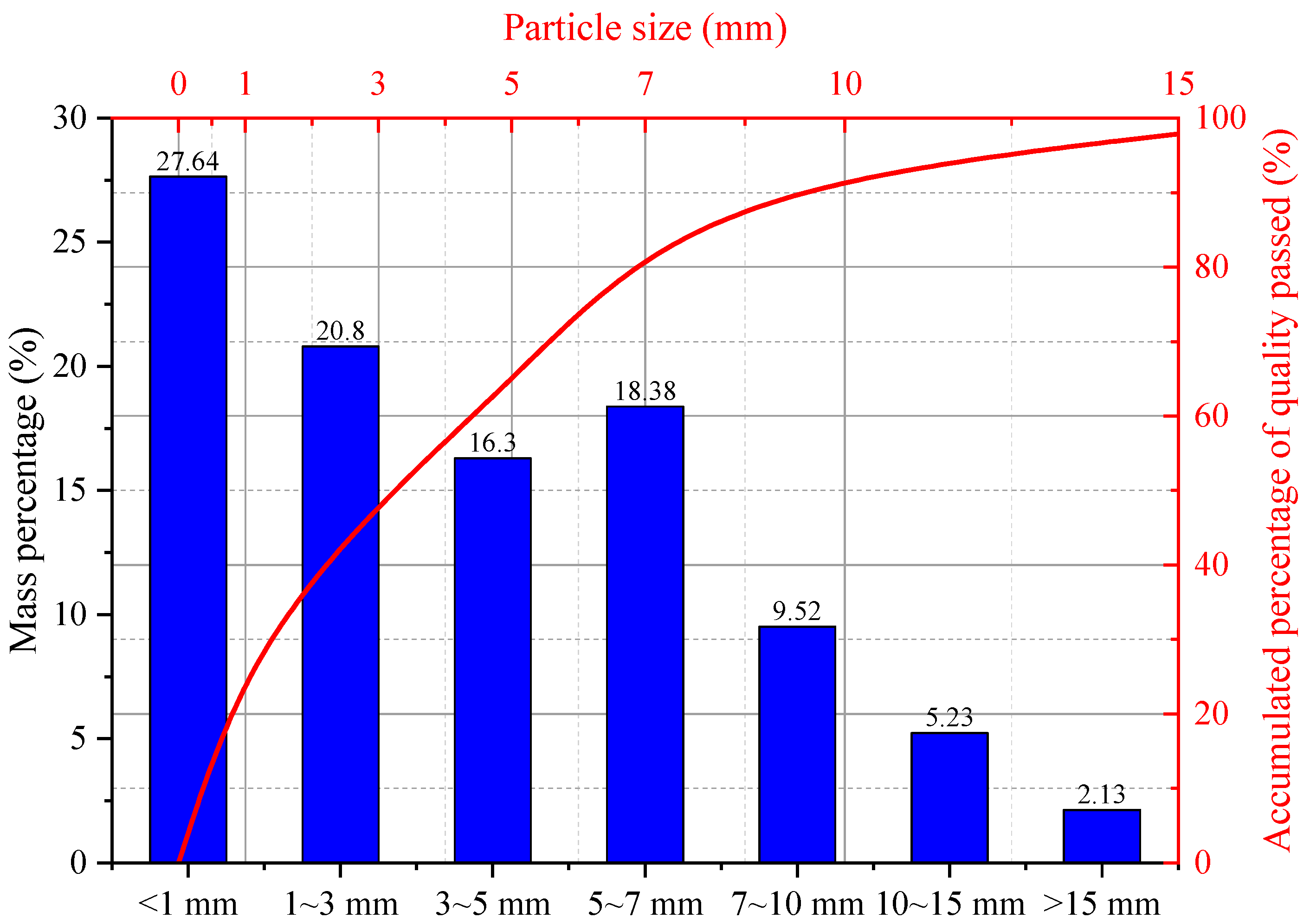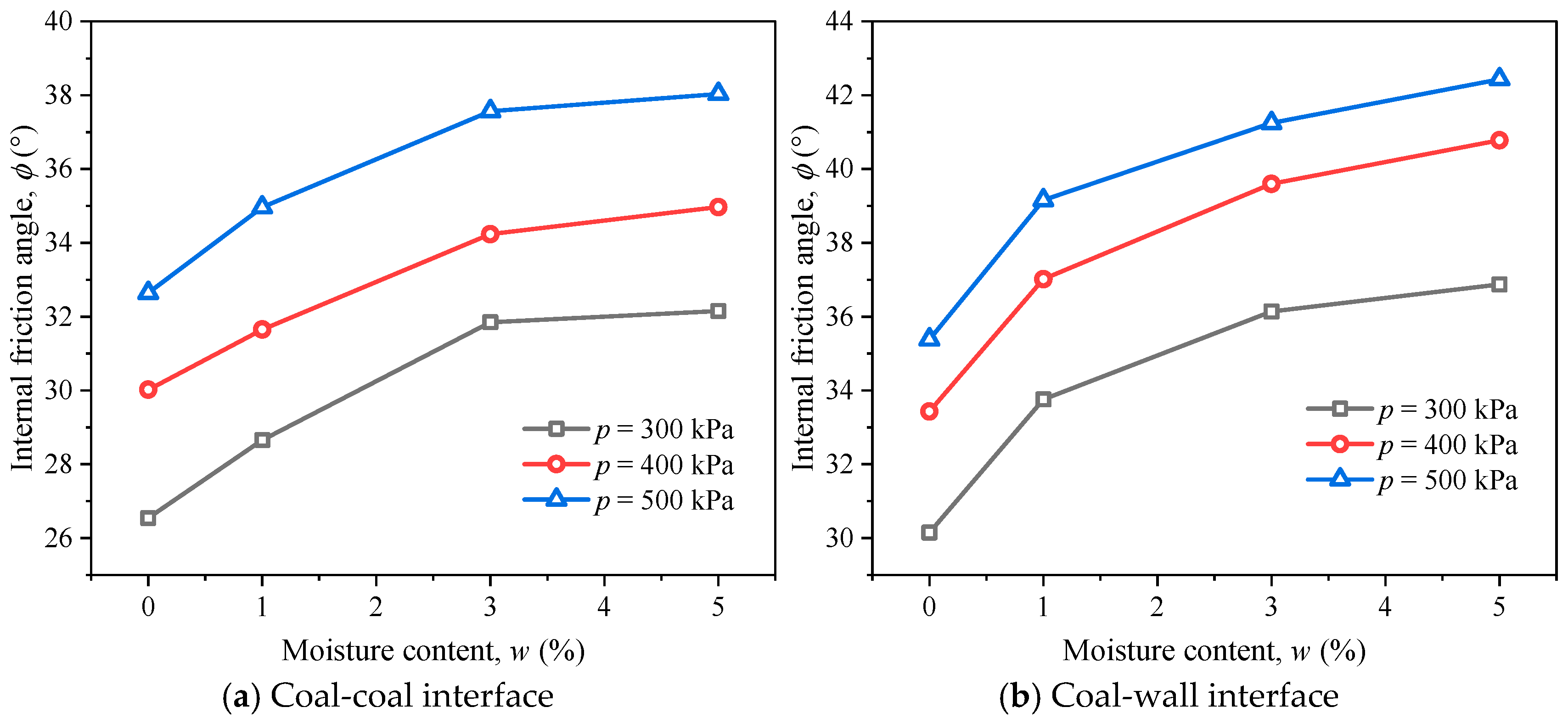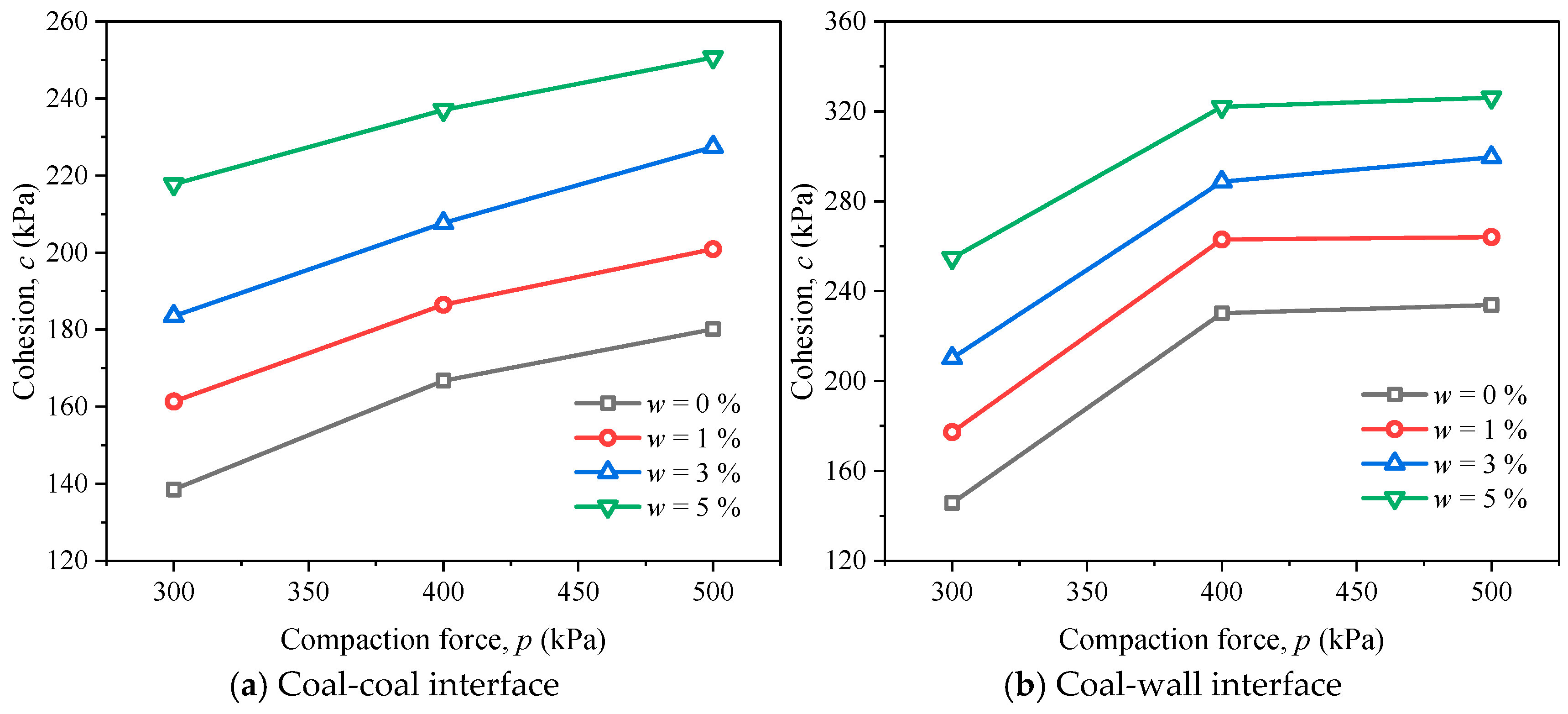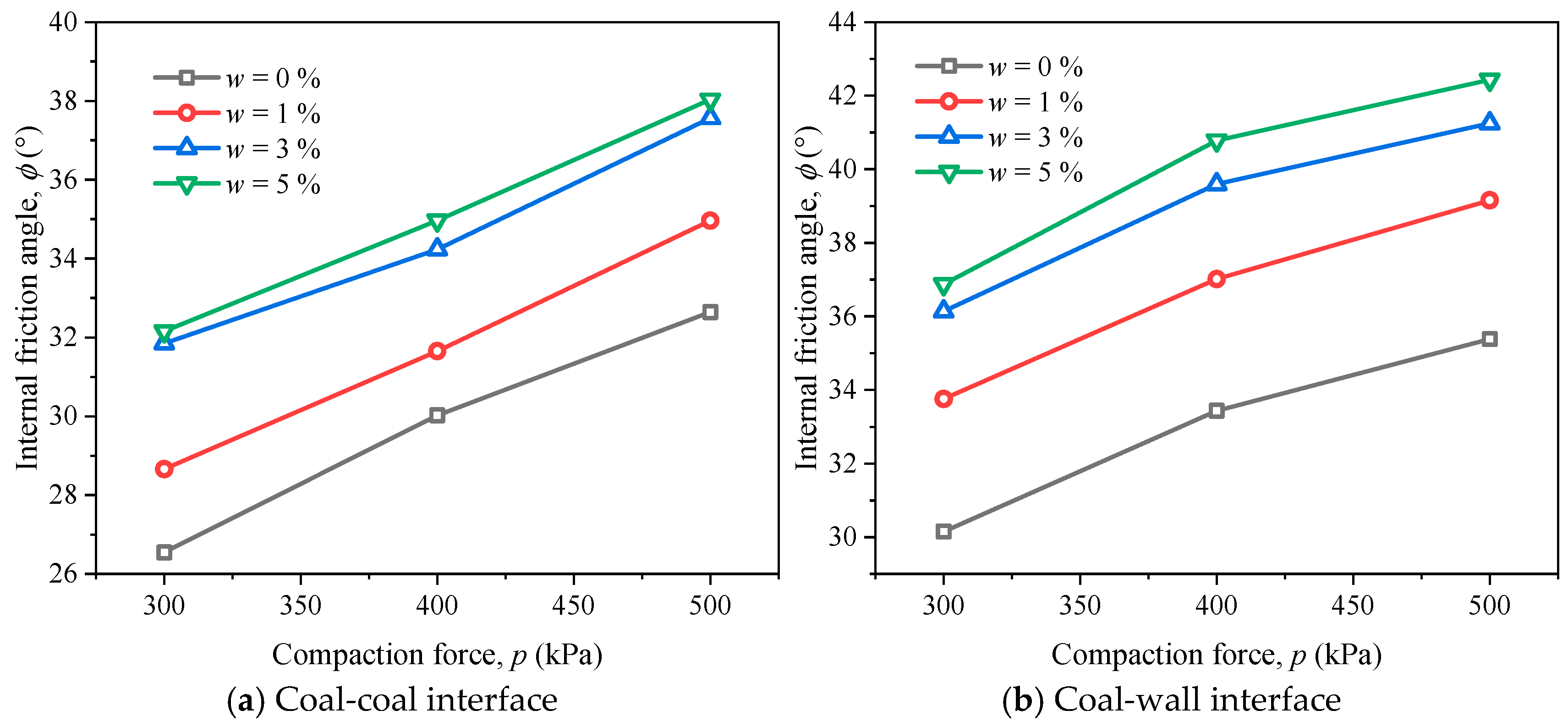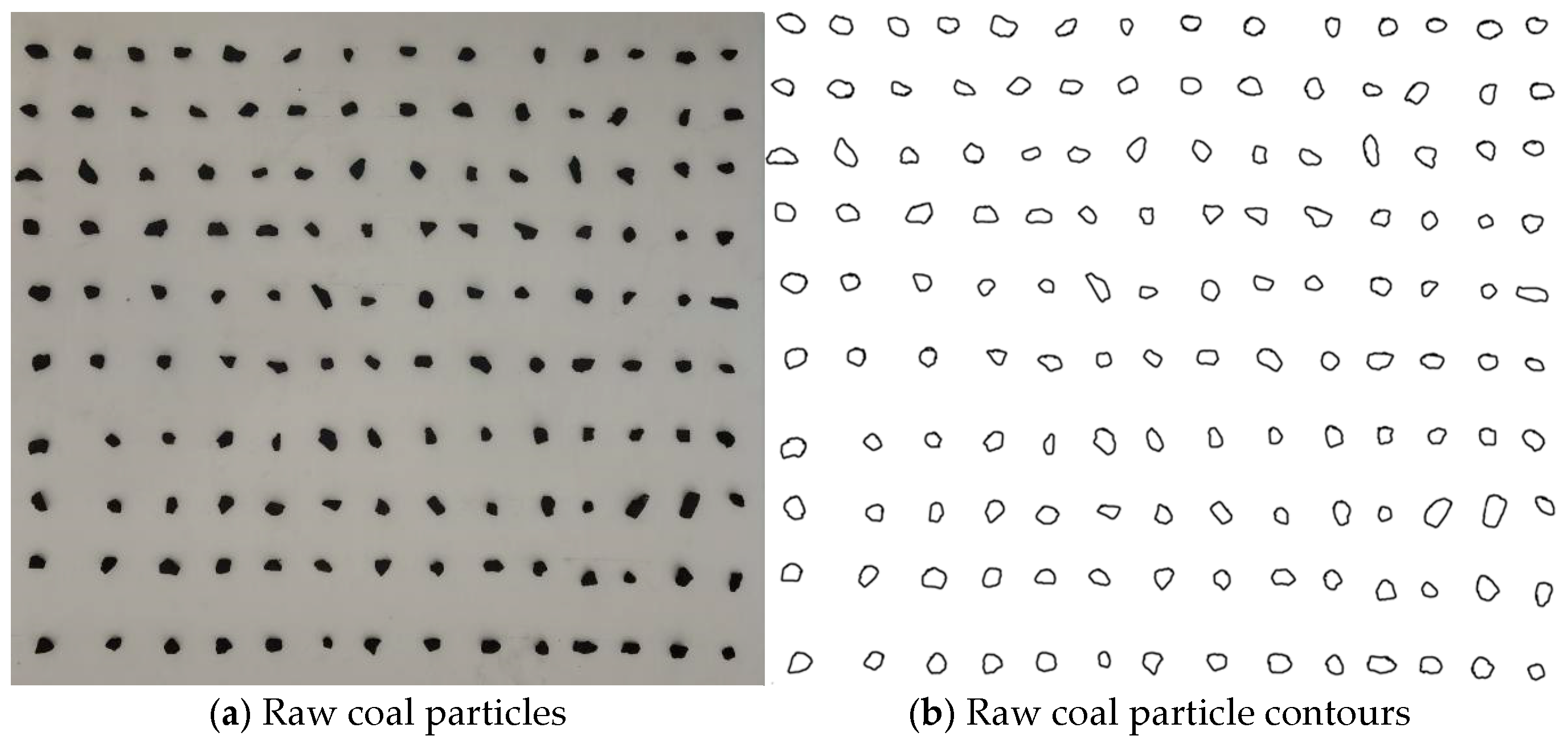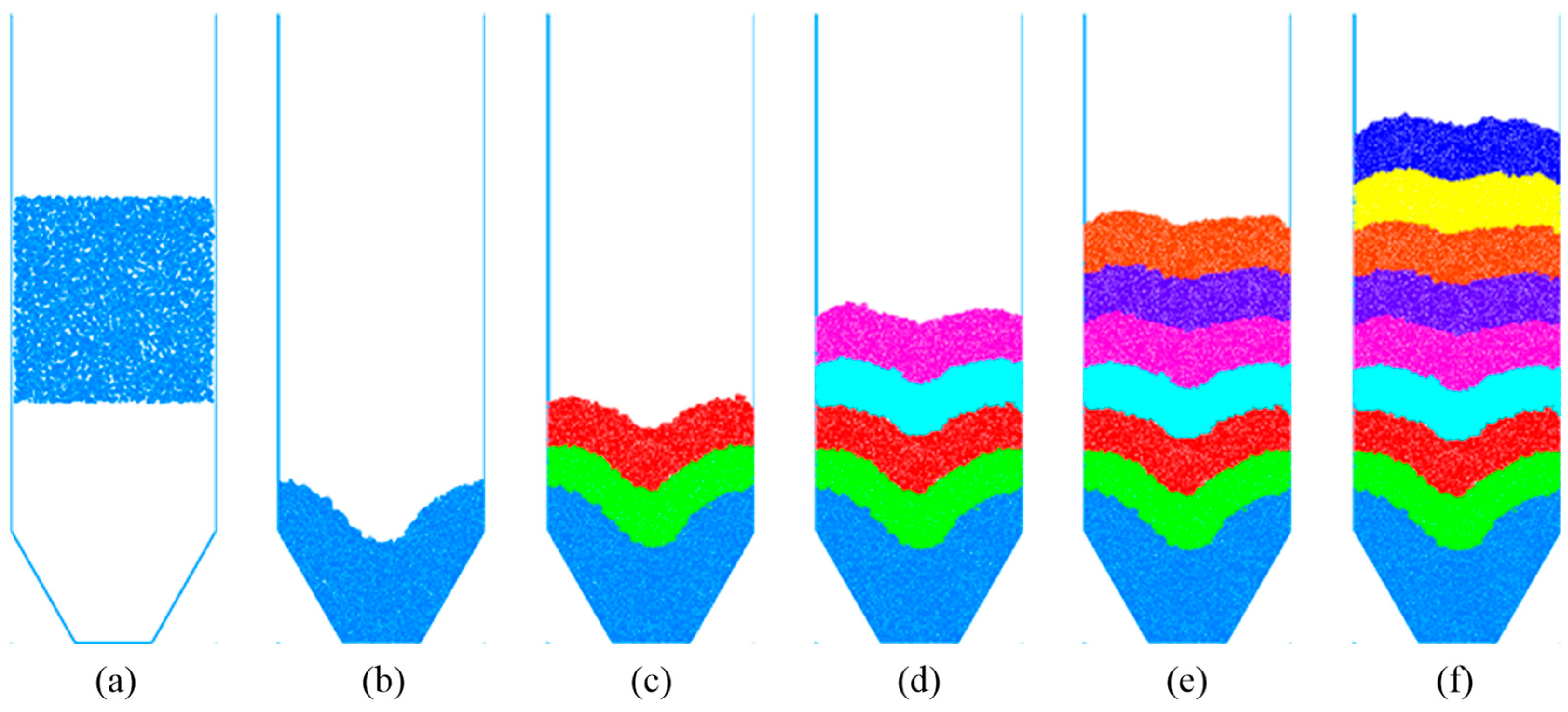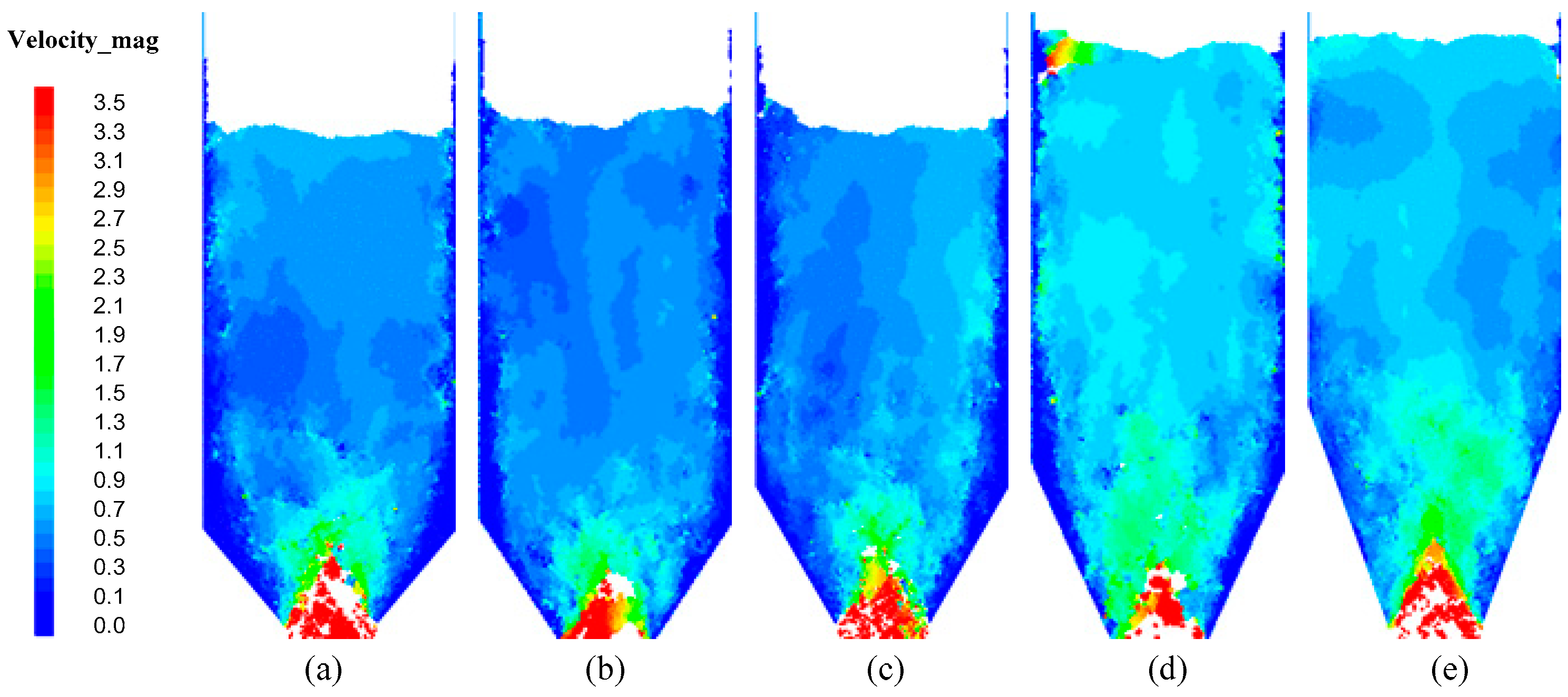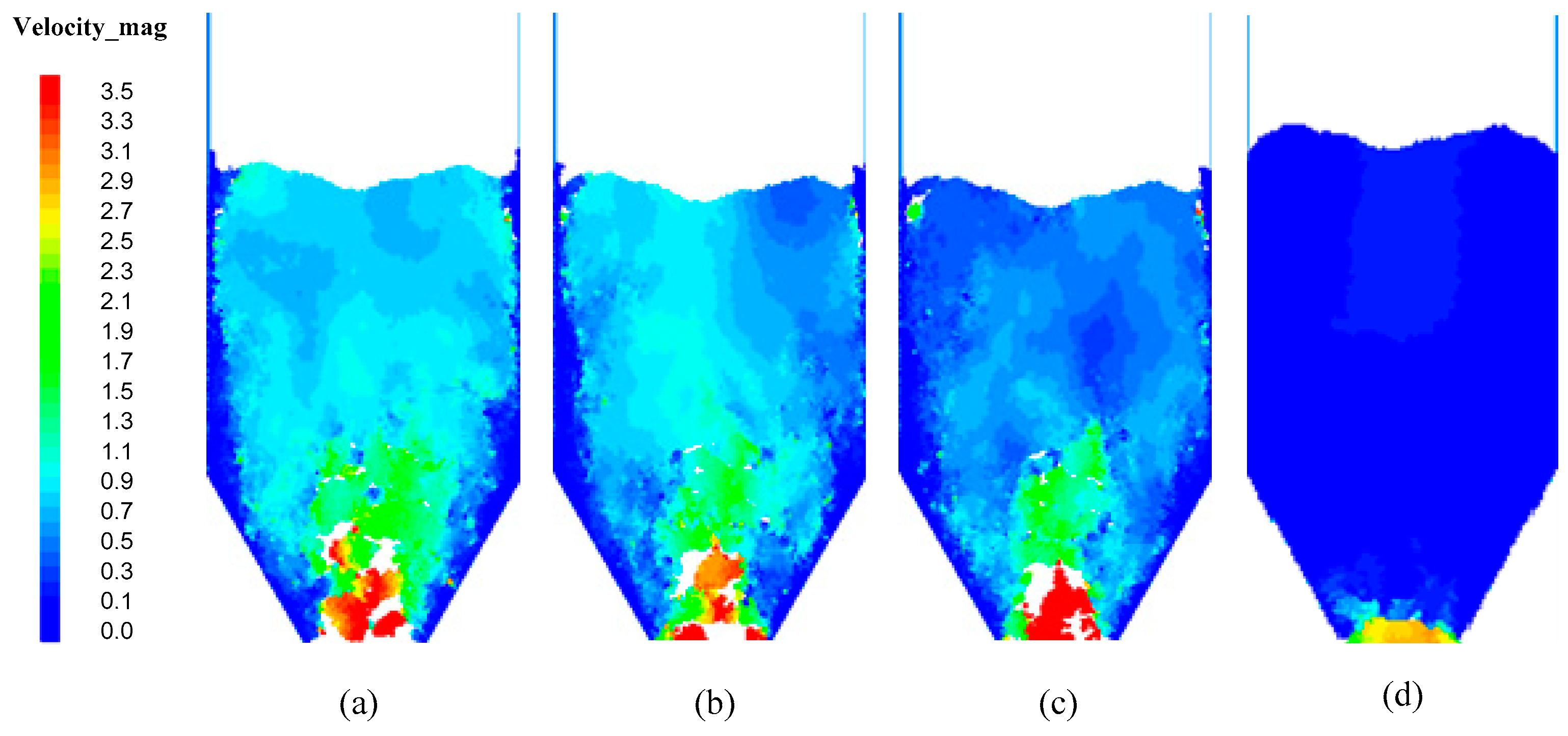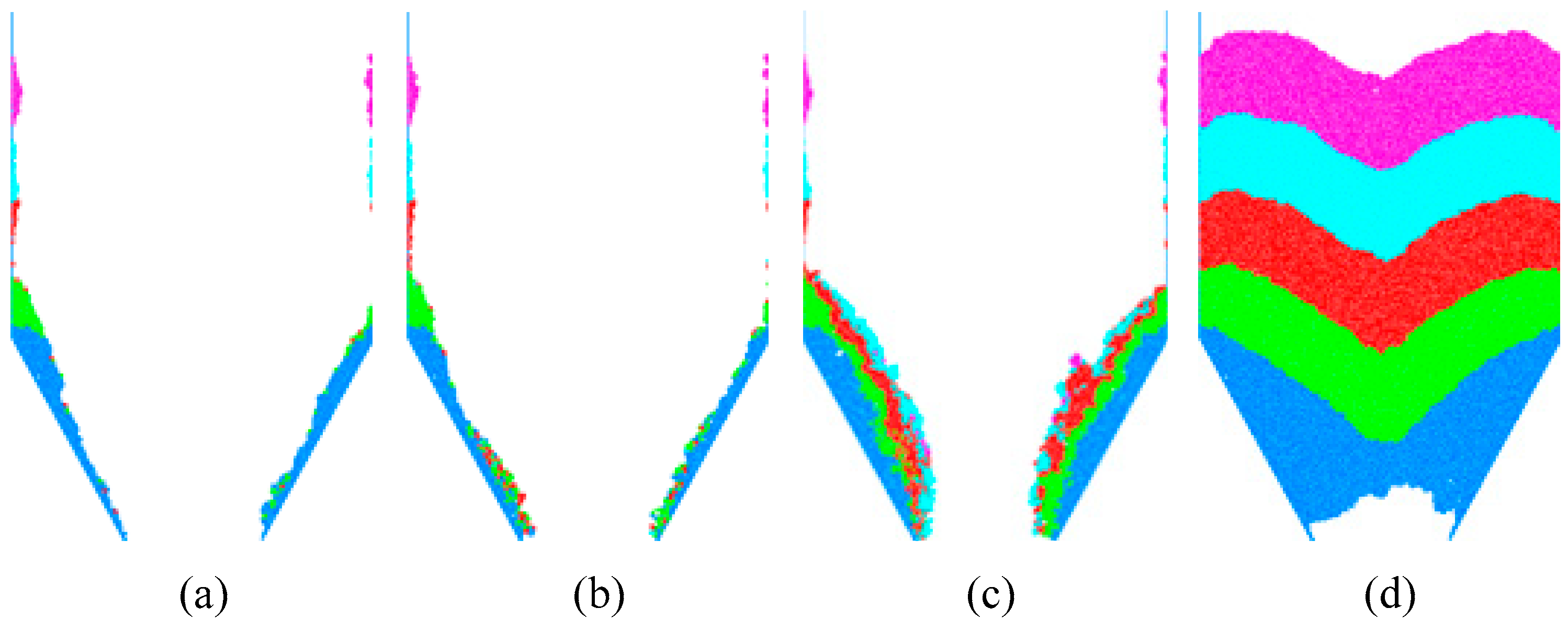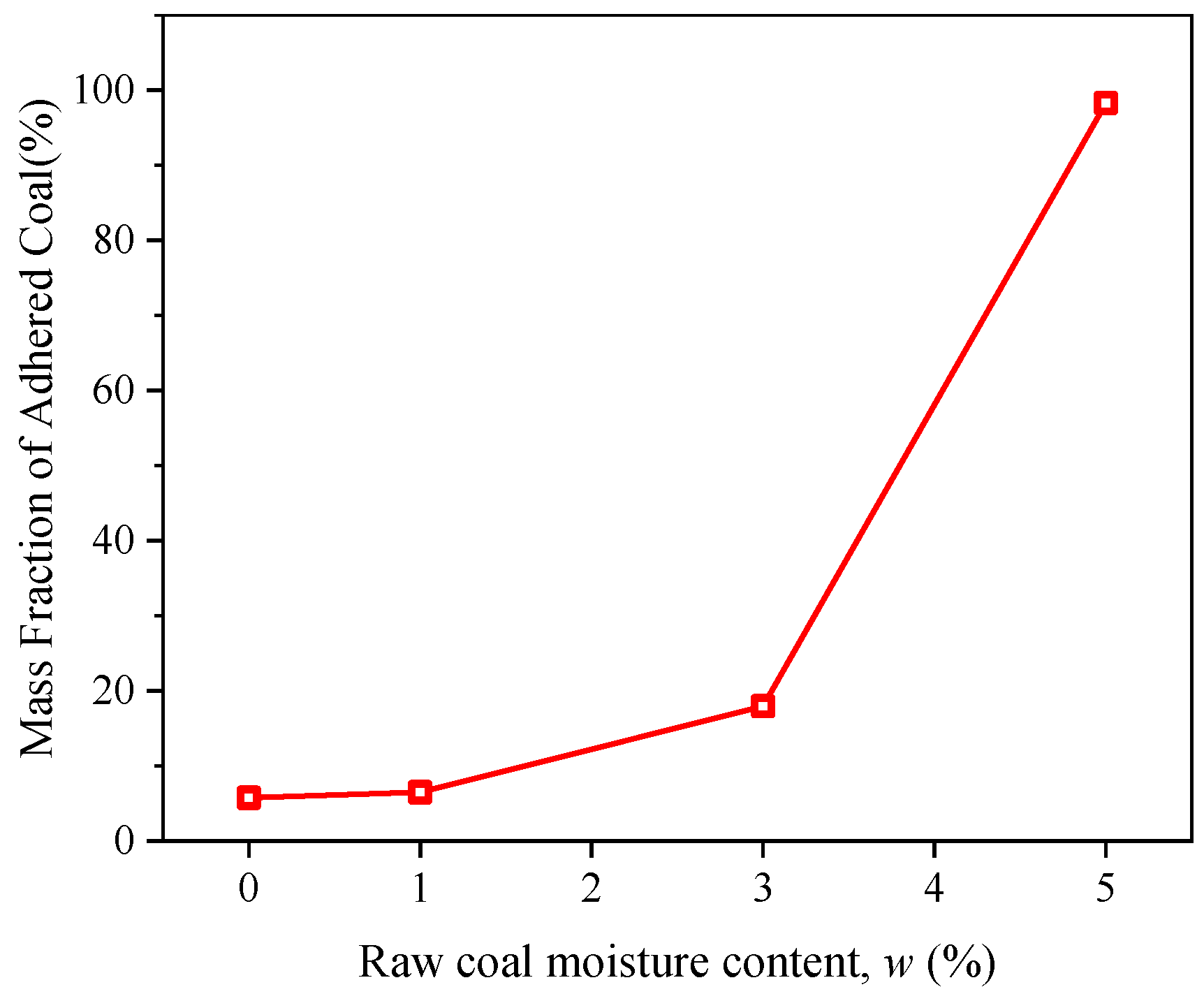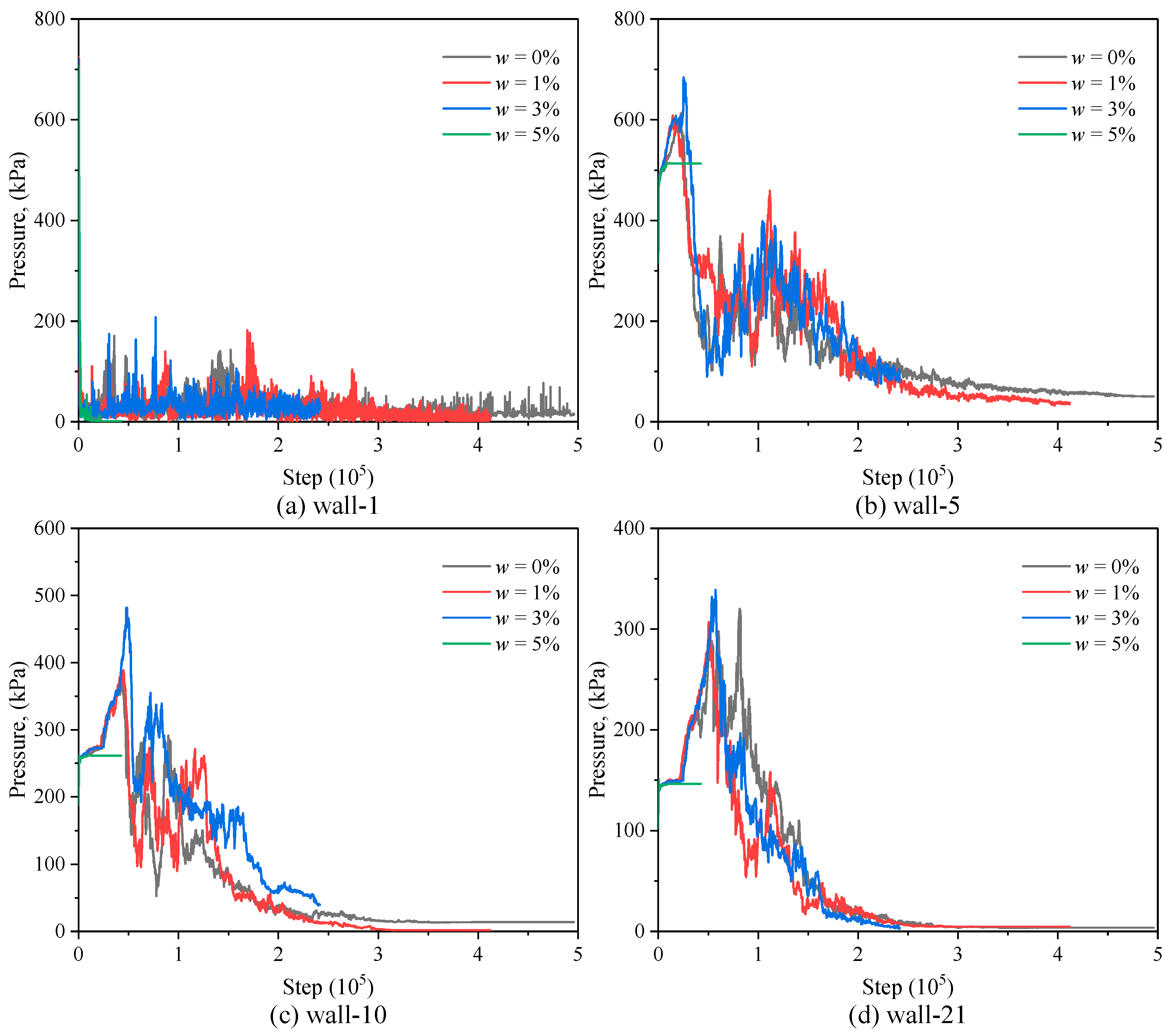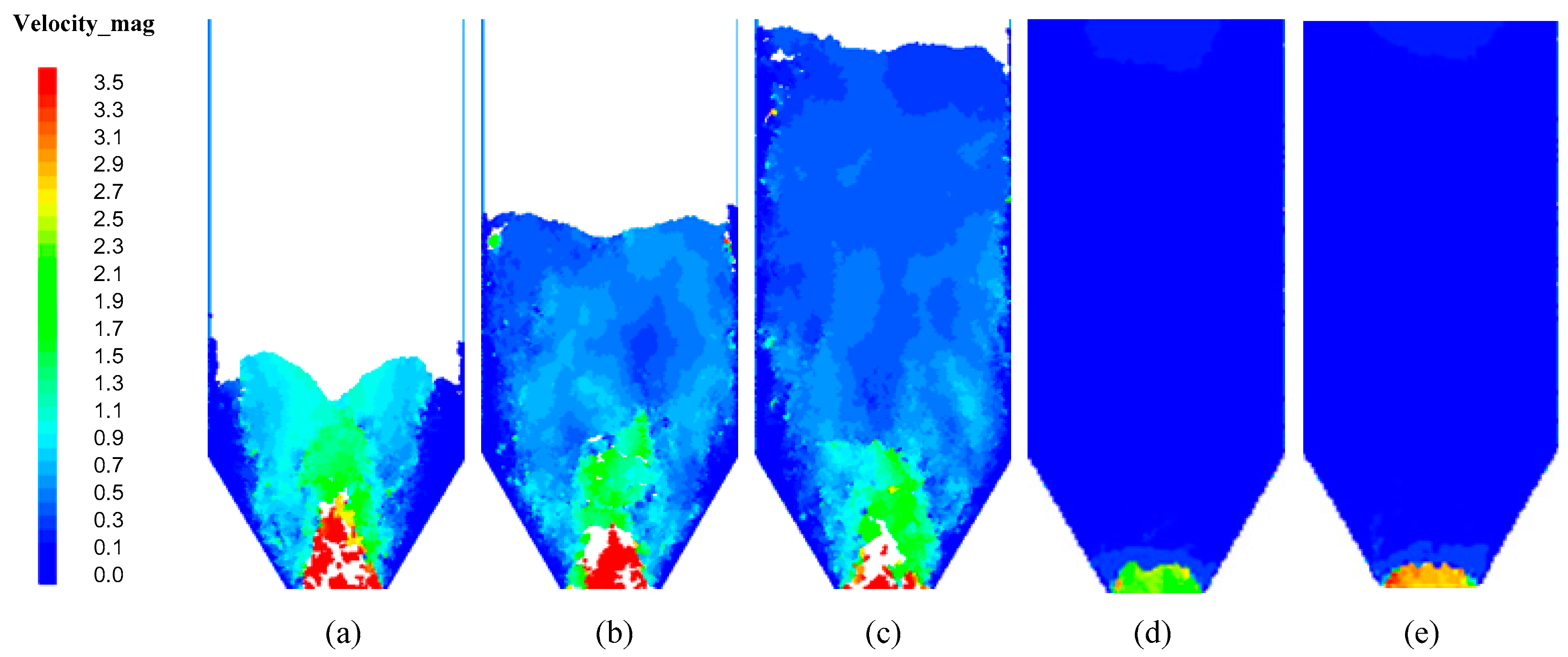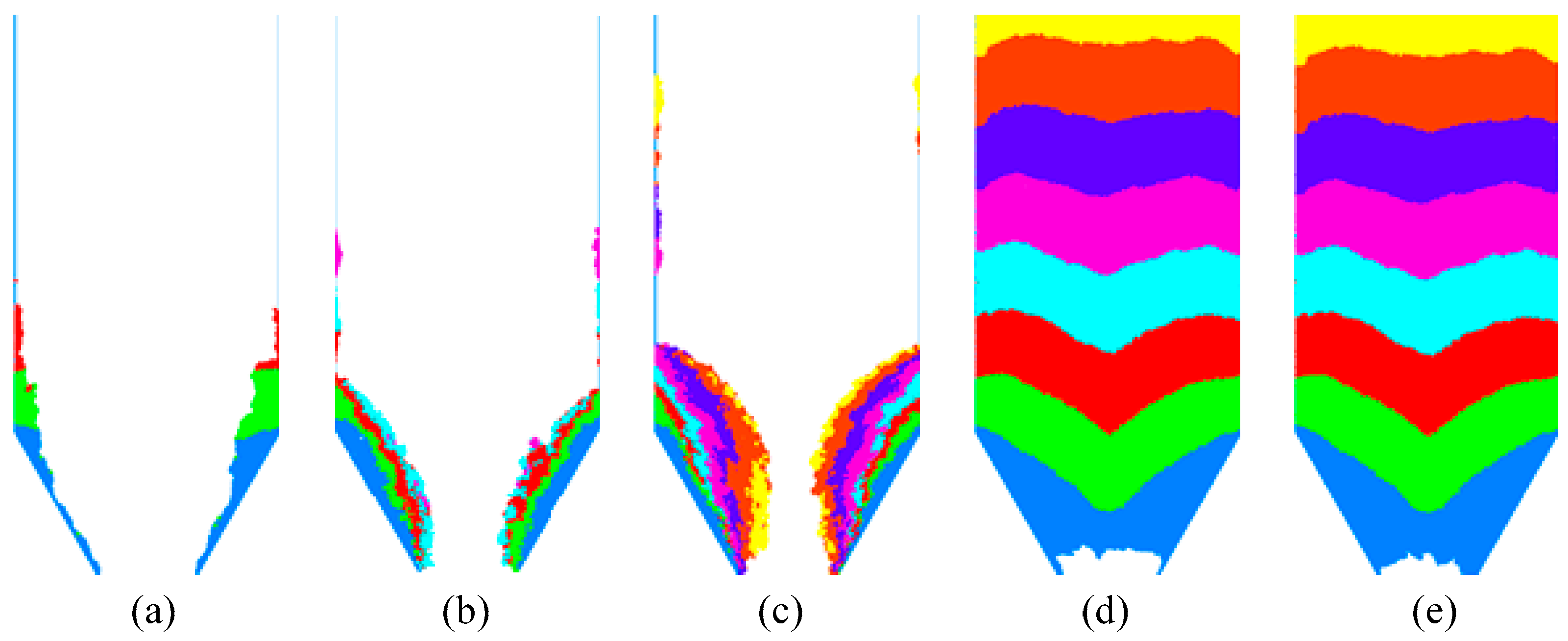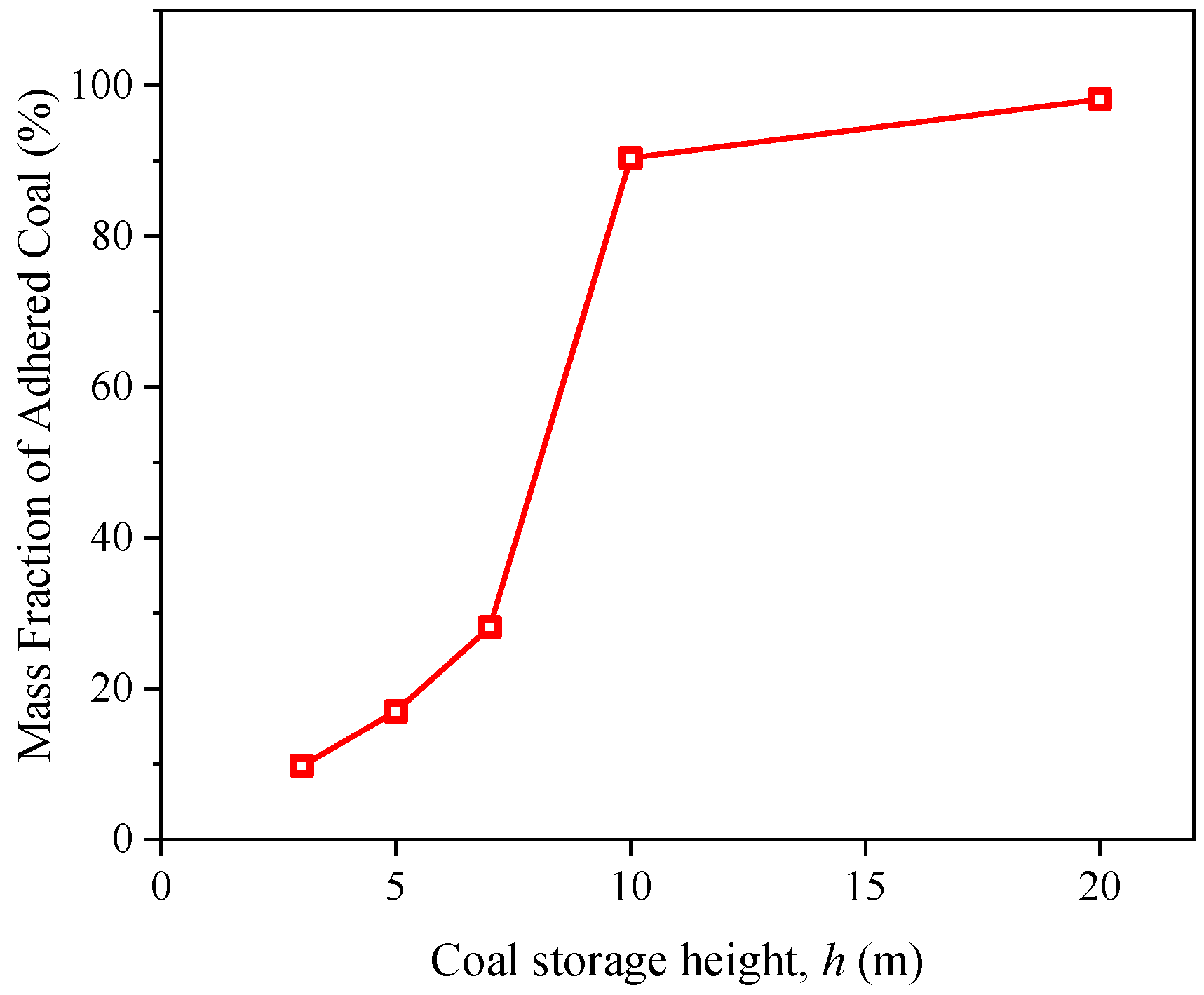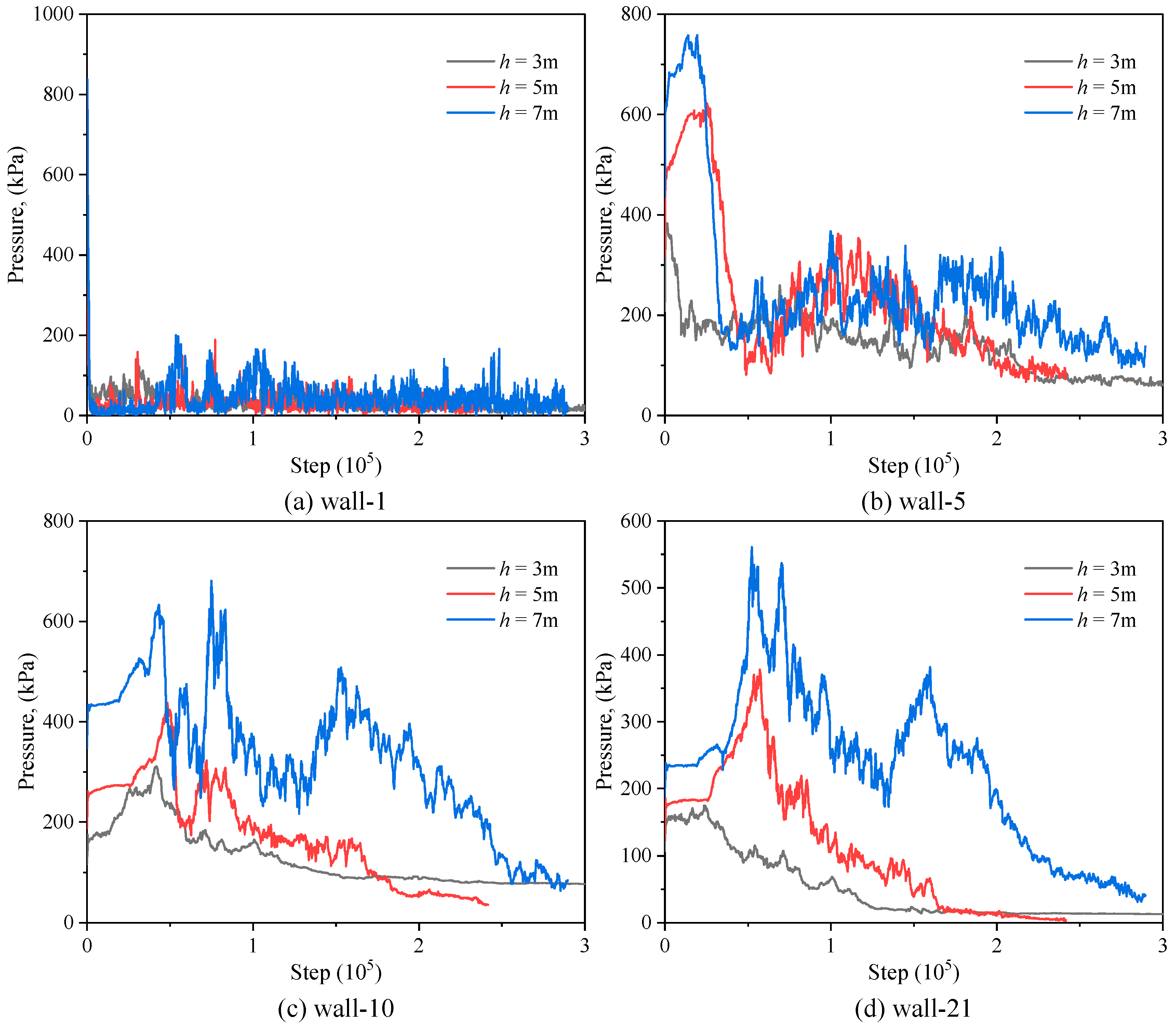Based on the numerical model and simulation method, three factors were selected for quantitative analysis of adhesive clogging characteristics using a single-factor analysis method: the bunker convergence angle α, raw coal moisture content w, and coal storage height h.
3.3.1. Influence of Convergence Angle on Adhesive Clogging of Coal Bunker
- (1)
Coal flow characteristics
The study simulated and analyzed five different bunker convergence angles
α (50°, 55°, 60°, 65°, 70°) at a coal storage height of 7 m and a raw coal moisture content of 1%.
Figure 15 shows the discharge flow velocity characteristics at different convergence angles.
As illustrated in
Figure 15, as the coal bunker convergence angle
α increases, the coal flow velocity gradually increases, and the flow pattern undergoes significant changes. When
α = 50° and 55°, the coal particles inside the bunker exhibit slow flow velocities, with a substantial amount of coal near the bunker wall having a flow velocity close to zero, displaying a typical central flow pattern. When
α = 60°, the coal flow velocity inside the coal bunker noticeably increases, and the flow pattern transitions from central flow to funnel flow. When
α = 65°, the coal flow velocity inside the bunker increases significantly, and the overall flow pattern becomes more akin to mass flow. When
α = 70°, the coal material flows downward uniformly, maintaining a high flow velocity, with the overall flow pattern distinctly exhibiting the characteristics of mass flow.
- (2)
Adhesive clogging situation of coal bunker
Figure 16 illustrates the adhesive clogging situation in the coal bunker at different convergence angles. When
α is in the range of 50° to 65°, multiple layers of coal accumulate inside the coal bunker (i.e., the upper layer of coal flows out before the lower layer, and some coal adhere to the inside of the bunker), which is also consistent with the characteristics of central flow. However, when
α = 70°, the coal bunker is primarily covered with coal adhering to the wall, which is mostly distributed in the order of coal storage, aligning with the adhesive clogging characteristics of a mass flow coal bunker.
Figure 17 depicts the curve of the mass fraction of adhered coal as a function of the convergence angle
α. It is observable that as
α increases, the mass fraction of adhered coal inside the bunker gradually diminishes. When
α is 50° and 55°, the mass fraction of adhered coal in the coal bunker is 12.57% and 10.11%, respectively. When
α is 60° and 65°, this fraction decreases to 5.15% and 3.91%, respectively, indicating a significant improvement in the coal adhesion situation inside the coal bunker. When
α is 70°, this fraction further decreases to 1.86%, which is due to the change in the coal flow pattern inside the coal bunker as the mass flow of coal results in only a small portion of coal adhering to the bunker wall.
- (3)
Pressure distribution on the coal bunker wall
Based on the adhesive clogging conditions in the coal bunker, we analyzed the pressure at four locations on the bunker walls: wall-1 at the coal bunker discharge outlet, wall-5 in the middle of the coal bunker hopper, and wall-10 and wall-21 at the junction between the hopper and the vertical section.
Figure 18 shows the pressure variation curves at these four locations. As depicted in
Figure 18a, at the coal bunker discharge outlet (wall-1), there are frequent collisions between coal particles and the bunker wall, resulting in significant fluctuations and lower wall pressure, which makes coal agglomeration and adhesion less likely.
Figure 18b–d illustrate the walls where sticky coal is more prevalent. At these locations, the wall pressure quickly rises to a peak at the onset of discharge and then gradually decreases with fluctuations. A comparison of the pressure curves for wall-5, wall-10, and wall-21 reveals that the pressure on the hopper walls is notably higher than on the vertical walls, with the highest pressure occurring in the middle of the hopper, indicating a higher likelihood of adhesive clogging.
Comparing the dynamic wall pressure changes during the discharge process at different coal bunker hopper angles reveals that the larger the hopper angle α, the faster the wall pressure decreases. Additionally, the steady-state wall pressure values suggest that as α increases, the pressures on the walls gradually diminish, reducing the contact force between the wall and the coal particles, thus making coal less likely to stick to the walls. Therefore, increasing the coal bunker hopper angle can effectively control adhesive clogging. However, it should be noted that with larger angles, the coal flow rate increases, making the discharge process more difficult to control and potentially less safe.
Based on the above analysis, when α is 60°, the coal flow is more efficient, the adhesive clogging situation of the coal bunker is significantly improved, and the dynamic wall pressure is relatively stable, ensuring the safe and efficient operation of the coal bunker. Therefore, we consider 60° to be a suitable coal bunker convergence angle (subsequent simulations in this study are also based on α = 60°).
3.3.2. Influence of Raw Coal Moisture Content on Adhesive Clogging in Coal Bunker
- (1)
Coal flow characteristics
This study conducted simulations under conditions of a coal storage height of 5 m and a bunker hopper angle of 60°, with varying raw coal moisture contents of
w = 0%, 1%, 3%, and 5%.
Figure 19 presents the characteristics of coal discharge flow velocity under different moisture content conditions.
From this figure, it can be observed that the raw coal moisture content has a significant impact on the coal flow characteristics. When w = 0%, except for a small amount of coal adhering to the wall, the overall flow velocity of the coal is relatively high, exhibiting mass flow characteristics. When w = 1% and 3%, the coal flow velocity decreases, and low-velocity adhered coal appears near the bunker wall, with a high-velocity channel forming in the center of the bunker. The coal flow pattern transitions from mass flow to central flow, which is due to the increased moisture content enhancing the adhesion of the coal, leading to a higher flow velocity in the center as the coal in the center is less affected than the coal near the bunker wall. When w = 5%, only the coal at the discharge outlet loses support and flows out of the coal bunker, while the flow velocity of the remaining coal is close to zero, resulting in an arching blockage.
- (2)
Adhesive clogging situation of coal bunker
Figure 20 illustrates the adhesive clogging situation of the coal bunker at different raw coal moisture contents. When
w = 0%, the adhered coal in the coal bunker is distinctly layered, conforming to the mass flow characteristic. When
w = 1%, a small portion of the upper layer of adhered coal mixes with the bottom layer, causing the coal flow pattern to transition to central flow. When
w = 3%, a substantial amount of mixed adhered coal is observed, which is more consistent with the characteristics of central flow. The simulation test results of coal bunker adhesive clogging can be correlated with the coal bunker flow pattern characteristics depicted in
Figure 20.
Figure 21 depicts the curve of the mass fraction of adhered coal in the coal bunker as a function of raw coal moisture content. It can be observed that as the moisture content
w increases, the fraction of adhered coal in the coal bunker exhibits an exponential growth trend. When
w = 0%, 1%, there is only a small amount of adhered coal in the coal bunker, with mass fractions of 5.76% and 6.31%, respectively. When
w = 3%, the amount of adhered coal in the coal bunker increases significantly, with the mass fraction increasing to 17.97%, more than triple the value at lower moisture contents, and a substantial amount of coal agglomeration occurs inside the bunker. When
w = 5%, an arching blockage occurs in the coal bunker, and the mass fraction of adhered coal reaches 98.26%. These findings demonstrate that the raw coal moisture content has a significant impact on the coal flow, and coal with higher moisture content is more prone to causing adhesion and increasing the risk of blockage in the coal bunker.
- (3)
Pressure distribution on the coal bunker wall
The dynamic wall pressure variation curves in
Figure 22 show that wall pressure changes with moisture content correspond to the bunker’s adhesive clogging conditions. When
w = 0% and 1%, the wall pressure curves of the coal are similar, with closely related adhesive clogging situations. When
w = 3%, the peak wall pressure is relatively high, facilitating coal adhesion to the wall, and thus the amount of adhered coal increases significantly. When
w = 5%, an arching blockage occurs in the coal bunker, which stabilizes shortly after the discharge begins, and the wall pressure remains predominantly static without a significant peak.
The study indicates that at lower moisture content, the coal flow in the bunker exhibits mass flow with lower wall pressure, resulting in less adhesive clogging. As moisture content increases, coal adhesion strengthens, the flow pattern shifts from mass flow to funnel flow, and bunker wall pressure rises, leading to coal adhesion and agglomeration, and consequently, adhesive clogging. Therefore, the raw coal moisture content is a critical factor in adhesive clogging issues in coal bunkers. By controlling the moisture content to improve coal flow, the risk of adhesive clogging can be effectively reduced.
3.3.3. Influence of Coal Storage Height on Adhesive Clogging of Coal Bunker
- (1)
Coal flow characteristics
In this study, under the conditions of a hopper angle
α = 60° and a raw coal moisture content
w = 3%, we set coal storage heights
h at 3 m, 5 m, 7 m, 10 m, and 20 m, with the numerical calculation model depicted in
Figure 23.
Simulation calculations provided insights into the distribution of coal discharge flow velocities at varying storage heights, as shown in
Figure 24. At
h = 3 m, the coal flow velocity within the bunker is relatively high, exhibiting characteristics of mass flow. Conversely, at
h = 5 m and 7 m, the flow velocity decreases significantly, transitioning to funnel flow. At
h = 10 m and beyond, the coal movement is negligible, leading to arching and blockage. It is evident that as storage height increases, the compaction force and adhesive interactions between coal particles intensify, affecting flow velocity and altering the flow state, which in turn increases the occurrence of adhesive coal and, in severe cases, results in arching blockages.
- (2)
Adhesive clogging situation of coal bunker
Figure 25 shows the adhesive blockage conditions in coal bunkers at various storage heights. At
h = 3 m, the distribution of adhesive coal aligns with the storage sequence, and coal discharges in an orderly mass flow state. At
h = 5 m and 7 m, adhesive coal forms layered mixed deposits, consistent with a “last-in, first-out” pattern. Thus, the storage height influences the flow state of coal, affecting the distribution of adhesive blockages within the bunker.
Figure 26 presents the variation curve of the adhesive coal mass fraction with storage height. It indicates that at
h = 3 m, 5 m, and 7 m, the bunker experiences varying degrees of adhesive coal, with mass fractions of 9.78%, 16.97%, and 28.14%, respectively. At
h = 10 m and 20 m, arching blockages occur, with mass fractions reaching 90.36% and 98.18%, respectively, severely affecting the bunker’s functionality.
- (3)
Pressure distribution on the coal bunker wall
Given that severe arching blockages occur at
h ≥ 10 m, resulting in minimal changes in wall pressure, this study focuses on bunkers with storage heights of 3 m, 5 m, and 7 m. Dynamic pressure changes on the walls during discharge are shown in
Figure 27. As
h increases, the initial static pressure on the bunker wall increases significantly, the compaction force on the coal increases, the contact force between the coal particles increases, and the adhesion effect is enhanced. Simultaneously, the peak dynamic wall pressure during the discharge process increases significantly, prompting the coal to adhere to the bunker wall more frequently and thus exacerbating the coal adhesion.
In conclusion, the coal storage height in bunkers affects the degree of coal compaction and flow state, leading to adhesive blockages. Scientific planning of storage height can reduce contact forces between coal particles or between coal and bunker walls, lowering the likelihood of blockages and ensuring efficient operation of underground coal bunkers.
